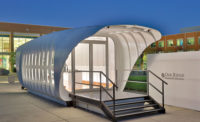Despite its title, Kinetic Architecture is not a book about buildings with components that literally move. Instead, its authors, Russell Fortmeyer and Charles D. Linn (both former editors at Architectural Record), investigate projects with envelopes that dynamically respond—in ways both visible and invisible—to their surroundings in order to modulate the interior environment, conserve energy, and enhance the comfort of occupants.
Linn, an architect and director of communications for the University of Kansas School of Architecture, and Fortmeyer, an electrical engineer and sustainable-technology specialist at Arup, put dynamic facades in context, examining their historical roots in a series of essays. But the meat of the book is a set of case studies investigating projects from around the world that have been completed in the last decade or are under way—buildings that have benefited from relatively recent developments in modeling and analysis tools, control systems, and glazing and other materials.
The projects featured vary from the widely publicized, like Renzo Piano's California Academy of Sciences, in San Francisco (completed in 2008), with its hilly, living roof, to the less well-known, such as Pei Cobb Freed & Partners' Milstein Family Heart Center (completed in 2010), in New York. The latter project has a transparent “climate wall” that helps control interior temperatures while providing views of the Hudson River. The book includes self-consciously iconic buildings, like the towers of Aedas's Abu Dhabi Investment Council Headquarters, with their operable shading screens inspired by traditional Arabic mashrabiyas. But it also features more subdued projects like William McDonough's Ames Research Center on the NASA campus in Moffett Field, California, which has an exoskeleton that doubles as an armature for shading devices and solar panels.
For each of the 24 case studies, Fortmeyer and Linn go to great lengths to explain how the building enclosure is part of a system of interrelated subsystems. They describe how the envelopes work in concert with other building systems—systems for lighting and daylighting, active and passive cooling, and natural and mechanical ventilation—to create a high-performance ensemble. In short, although Kinetic Architecture is a book that focuses on facades, its analysis is more than skin deep.
Kinetic Architecture by Russell Fortmeyer and Charles D. Linn. Images Publishing, April 2014, 224 pages, $78.





Post a comment to this article
Report Abusive Comment